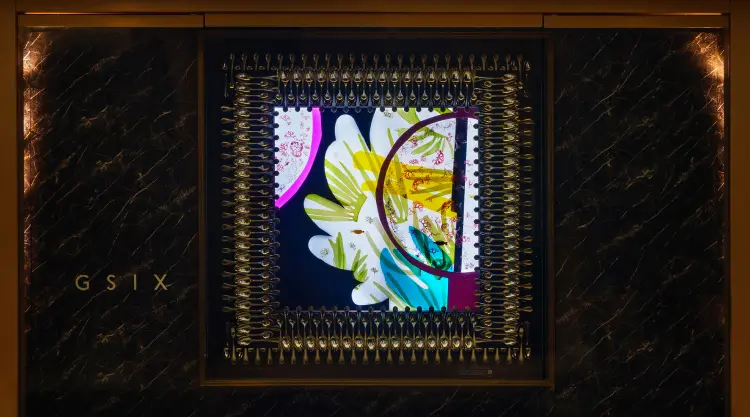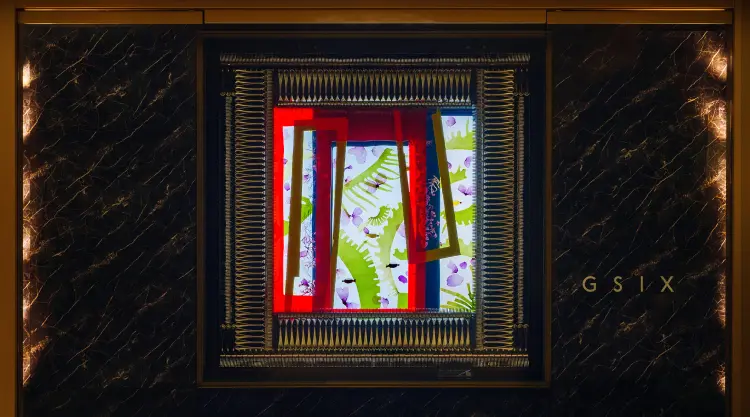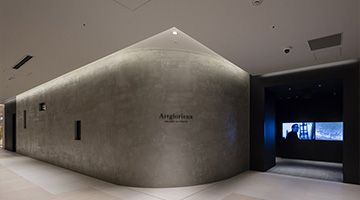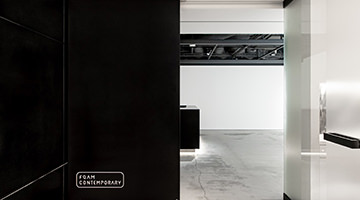ART
ART INSTALLATION
-
-
Kenji Yanobe
《 BIG CAT BANG 》
2F Central Atrium
2024.4.5 - 2025.Summer(planned)
-
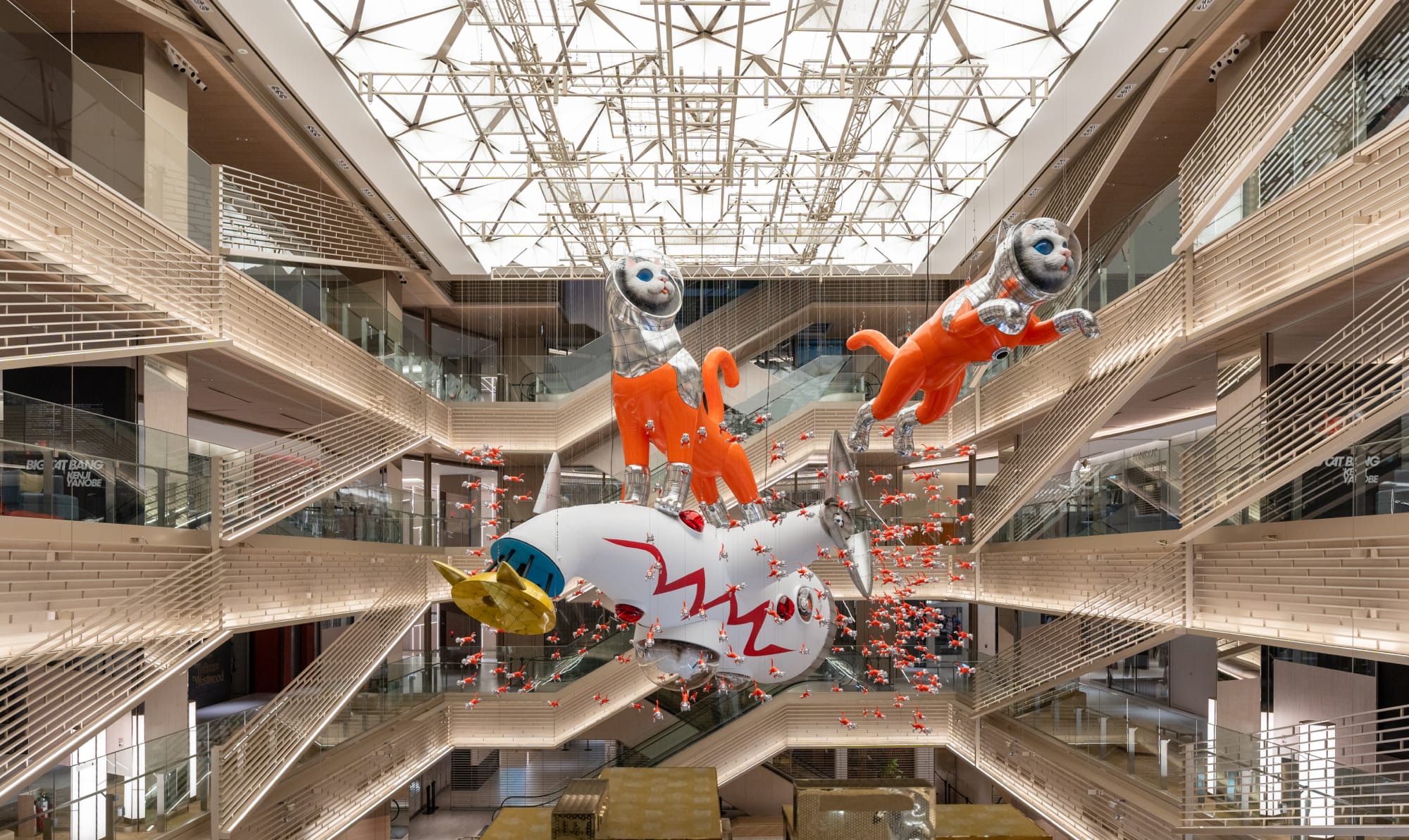
-
-
New to the atrium in the middle of GINZA SIX is a work titled BIG CAT BANG by Kenji Yanobe, a leading contemporary artist in Japan. The artwork is his new series of the SHIP’S CAT, which brings good fortune for those on a voyage.
Kenji Yanobe is known for his large mechanical sculptures that juxtapose humor with social commentary.
This work reimagines the large atrium in the middle of GINZA SIX as a galaxy that includes Earth, in which innumerable space cats voyage through space. The large floating ship is an homage to the Tower of the Sun, a tower created by Japanese artist Taro Okamoto for Expo 70. Kenji Yanobe, an heir in the spiritual line of Taro Okamoto, presents a new and whimsical version of the story of our dynamic universe since the Big Bang.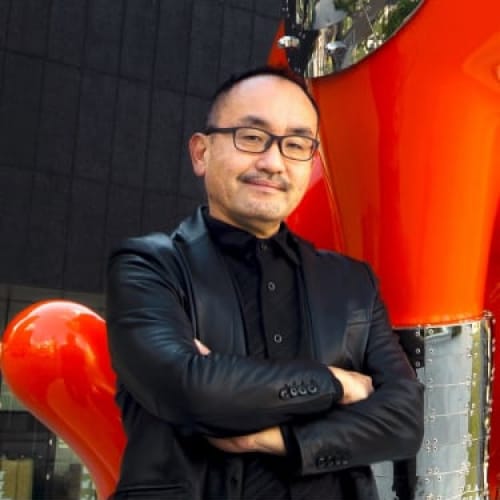
Kenji Yanobe
Contemporary Artist, Professor, Kyoto University of the Arts
Born in Osaka in 1965, Kenji Yanobe began making large mechanical sculptures with functionality at the start of the 1990s on the theme of survival in the contemporary society. His works, which convey social commentary in whimsical presentations, have won high praise both in Japan and abroad. In 2017, taking sailor cats as a motif, he began a SHIP’S CAT series depicting guardian deities for travelers. SHIP’S CAT (Muse) 2021 is permanently installed as the symbol of the Nakanoshima Museum of Art, Osaka, which opened in 2022.
PAST

-
Jean Jullien
《 The Departure 》
2F Central Atrium
2022.10.26 - 2024.3.31
The Central Atrium artworks are a symbol of GINZA SIX, and the latest arrival is visual artist Jean Jullien, who has exhibited works in countries around the world and continues to create endlessly varied works based on illustrations. In The Departure, he has accepted the challenge of creating a large-scale public artwork and produced his first aerial installation.
PAPER PEOPLE was born at a 2021 personal exhibition, and tells the story of “a character who realized he had been abandoned by the creator who had created him, and decided out of loneliness to create companions out of paper.” In the theme of this GINZA SIX installation, the characters are flying off the ground on paper carpets as they set out on a journey to explore the world. PAPER PEOPLE on five carpets of varying size fly at will around the atrium space. The title is The Departure. PAPER PEOPLE at GINZA SIX are made of metal rather than paper, and represent Jean Jullien’s first aerial installation.

Jean Jullien
Visual artist
After graduating from Central Saint Martins in 2008, Jean Jullien obtained a master’s degree from the Royal College of Art in 2010. As an illustrator, he has provided works to a wide range of clients including the New York Times, National Geographic, RCA Records, Le Centre Pompidou, Hermès, Petit Bateau, and Vogue. He has also been active in the production of paintings, and has held exhibitions in San Francisco, London, Berlin, Singapore, and other locations worldwide. His inspirations include numerous works of Japanese manga including Saint Seiya, Dragonball, and City Hunter, as well as the French manga works known as bande dessinee, the French poster artist Raymond Savignac, children’s book author Tomi Ungerer, and illustrator and manga artist Jean-Jacques Sempé. His wit-filled works are not limited by the concepts of fine art, and are born from a richly natural creativity.
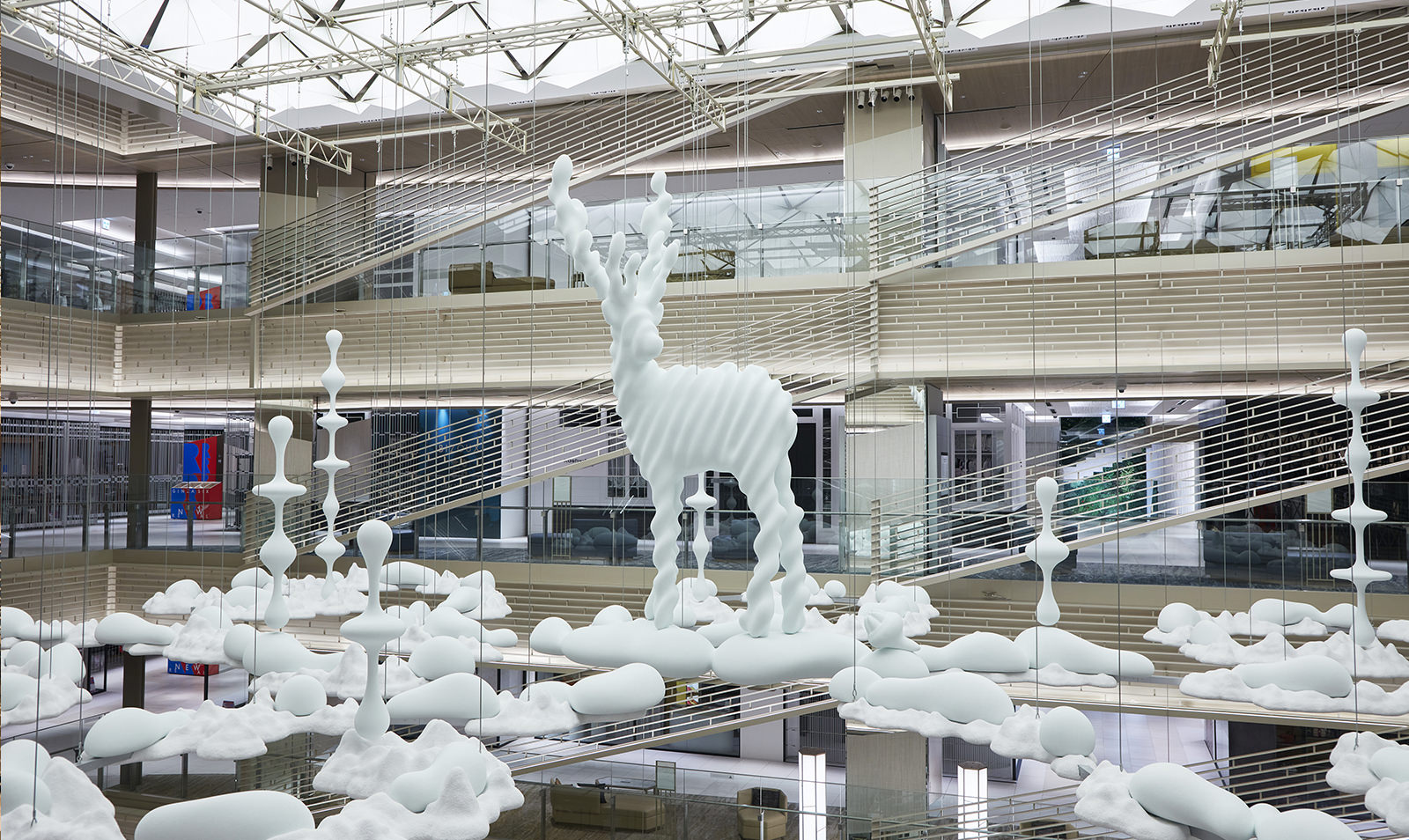
©Kohei Nawa | Sandwich Inc.
-
Kohei Nawa
《 Metamorphosis Garden 》
2F Central Atrium
2021.4.12 - 2022.10.20
Metamorphosis Garden is an installation with the theme of life, matter, and a world in which ambiguous entities coexist on the boundary between the two. Expressing the emergence of a new narrative out of chaos, it is a development from the Biota (Fauna/Flora) installation (2013) on Inujima island in the Seto Inland Sea. Ether and Trans-Deer emerge as symbols of life from irregularly shaped islands and droplets in a group of sculptures covered with alumina and microbeads floating in the atrium space. An augmented reality performance created in collaboration with choreographer Damien Jalet creates a constantly changing world in which real objects and images of augmented reality overlap.
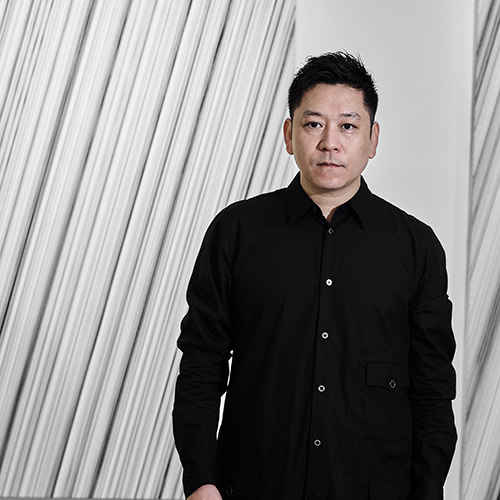
Kohei Nawa
Sculptor / director of Sandwich Inc. / professor at Kyoto University of the Arts
Born in 1975, and based in Kyoto, Japan, Kohei Nawa received a PhD in Fine Art/Sculpture from Kyoto City University of Arts in 2003, and established SANDWICH in 2009. Focusing on the surface “skin” of sculpture as an interface connecting to the senses, Nawa began his PixCell series in 2002 based on the concept of the cell, symbolizing the information age. Adopting a flexible interpretation of the meaning of sculpture, he produces perceptual experiences that reveal the physical properties of materials to the viewer through works addressing themes related to life and the cosmos and to artistic sensibility and technology, including Direction, in which he produces paintings using gravity, Force, in which silicone oil pours down through a space, Biomatrix, in which bubbles and grids emerge on a liquid surface, and Foam, in which bubbles form enormous volumes. Recently, Nawa has also worked on architectural projects, including the art pavilion Kohtei. VESSEL, a performance work produced in conjunction with Belgo-French choreographer and dancer Damien Jalet, has been presented around the world since its premiere in 2015. In 2018, his sculpture Throne was exhibited under the Pyramid at the Musée du Louvre in Paris, France.
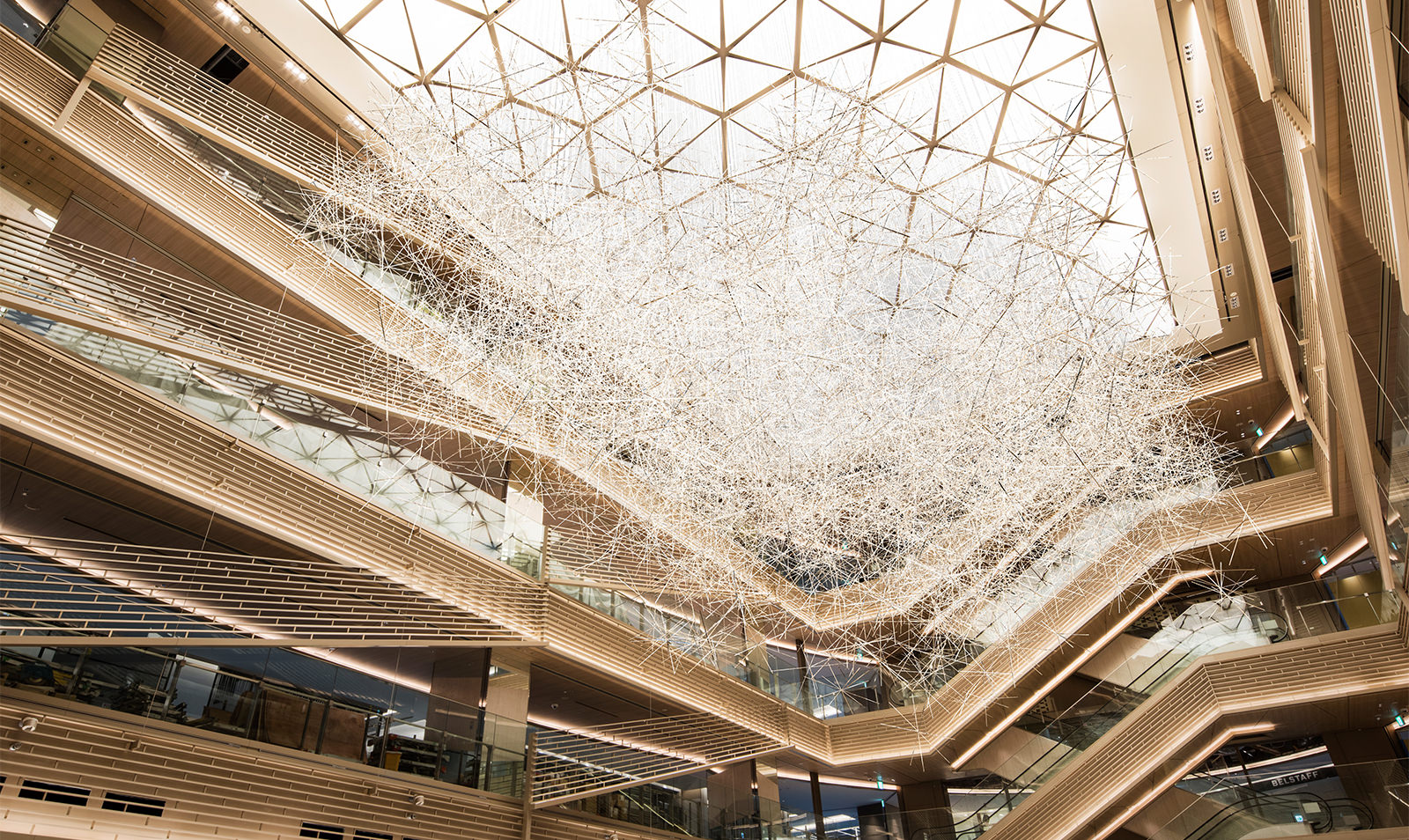
-
Tokujin Yoshioka
《 Prismatic Cloud 》
2F Central Atrium
2020.2.27 - 2021.2.23
The artist Tokujin Yoshioka is active in the fields of art, design, and architecture. His magnificent lyrical installations on natural themes have won international acclaim. The installation here at GINZA SIX is a sculpture of light which conjures up an image of an enormous cloud that transcends sensation.
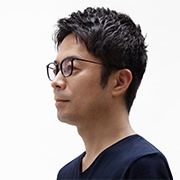
Tokujin Yoshioka
Artist. Born in 1967. Studied design under Shiro Kuramata and Issey Miyake; established Tokujin Yoshioka Inc. in 2000. Active in the fields of design, architecture, and contemporary art; his lyrical installations have earned him international acclaim. Major works include Water Block, on permanent display at Musée d’Orsay; Rainbow Church, an architectural work made of crystal prisms; VENUS, a crystal chair; KOU-AN, a glass tea house; and the Tokyo 2020 Olympic and Paralympic Torch. His works are in the permanent collections of The Museum of Modern Art, New York, Musée National d’Art Moderne in Paris, and other major museums around the world. Recipient of Mainichi Design Award, Minister of Education’s Art Encouragement Prize for New Artists, Design Miami – Designer of the Year, Milano Design Award – Winner, and numerous other international awards. Named one of Newsweek magazine’s 100 Most Respected Japanese in the World.

-
Klaus Haapaniemi
《 Celebration of Life in the Astral Sea 》
2F Central Atrium
November 5, 2019 – February 15, 2020
A retail promotion titled "Celebration of Life in the Astral Sea," was specially arranged and executed by Ginza Six. It features the vast world of the "Astral Sea," a design creation originally conceived by Finnish artist Klaus Haapaniemi. With the universe as its stage, the Lightning Whales travel the universe beyond space-time and come to life for all to see and experience in the central atrium.

Klaus Haapaniemi
Born in 1970 in Helsinki, Finland, Klaus Haapaniemi was influenced by the natural and traditional beauty of his native land. His work embodies a unique perspective, style, and feel, a fusion of fantasy and realism. In addition to the creative development of his original artworks, he has collaborated with a range of companies, including Iittala and Established & Sons. In 2015, he designed the costumes and stage decorations for the Finnish National Opera. In 2019, Kadokawa published the first collection of his works, Klaus Haapaniemi~ Yume no Fukei.
© 2019 KLAUS HAAPANIEMI All Rights Reserved.
Rights Management: Bluefolio Inc.
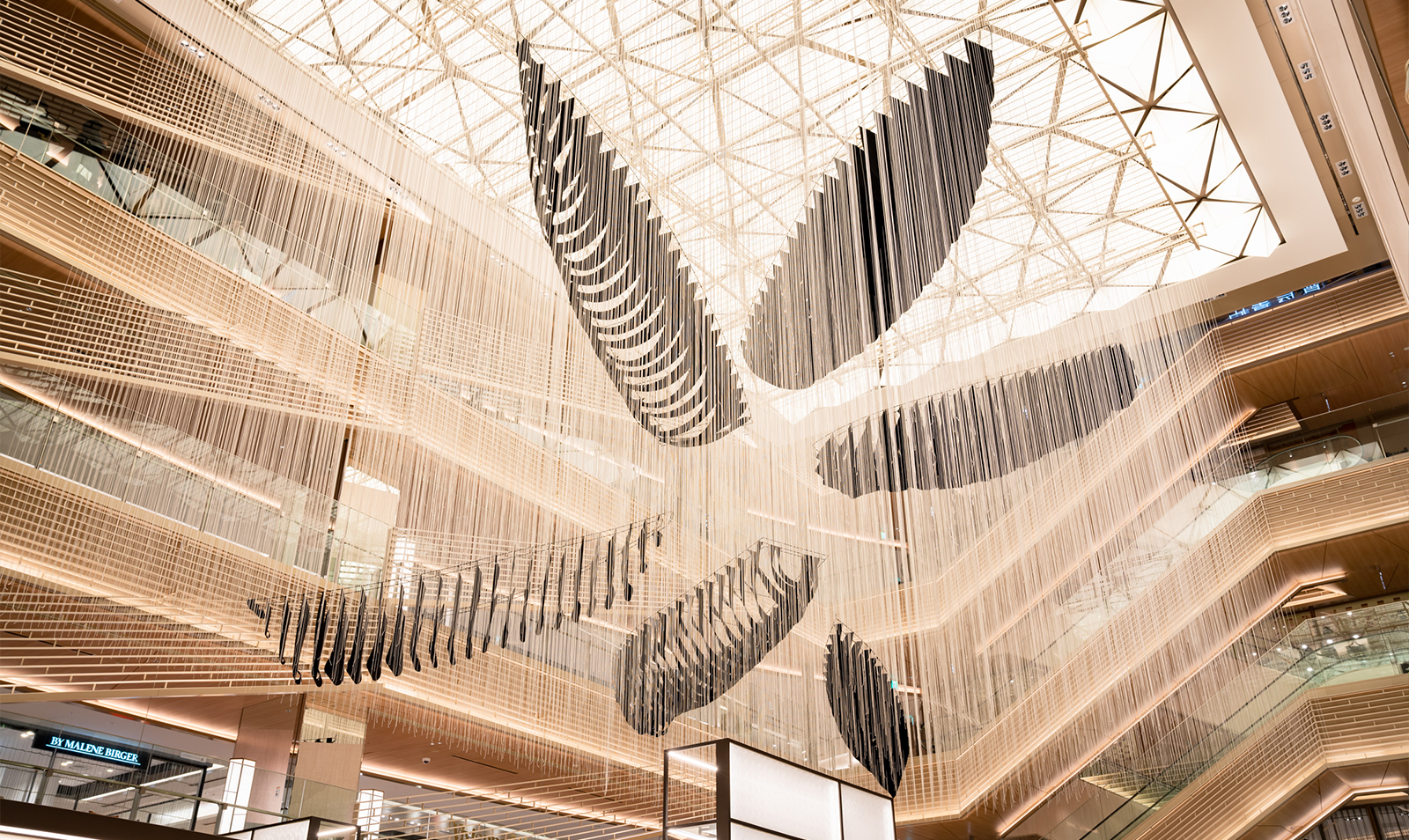
-
Chiharu Shiota
《 Six Boats 》
2F Central Atrium
February 27, 2019 - October 27, 2019
“Six Boats,” an installation of six five-meter-long boats held aloft in the central atrium space, depicts boats setting sail on Ginza’s sea of memories, navigating a host of postwar difficulties toward a grand recovery.
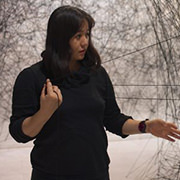
Chiharu Shiota
Born 1972 in Osaka Prefecture, currently based in Berlin. In 2008, Shiota received the Art Encouragement Prize from the Japanese Minister of Education, Culture, Sports, Science and Technology. In addition to solo exhibitions held across the world including Art Gallery of South Australia (2018), Yorkshire Sculpture Park (2018), Smithsonian Institution Arthur M. Sackler Gallery (2014), the Museum of Art, Kochi (2013), MIMOCA Marugame Genichiro-Inokuma Museum of Contemporary Art (2012), and the National Museum of Art, Osaka (2008), she has participated in numerous international exhibitions such as the Biennale of Sydney (2016), the Kiev Biennale (2012), and the Yokohama Triennale (2001). In 2015, she represented Japan at the 56th Venice Biennale International Art Exhibition. Plans to hold her largest individual exhibition ever at the Mori Art Museum in June 2019.
Photo: Ken Kato
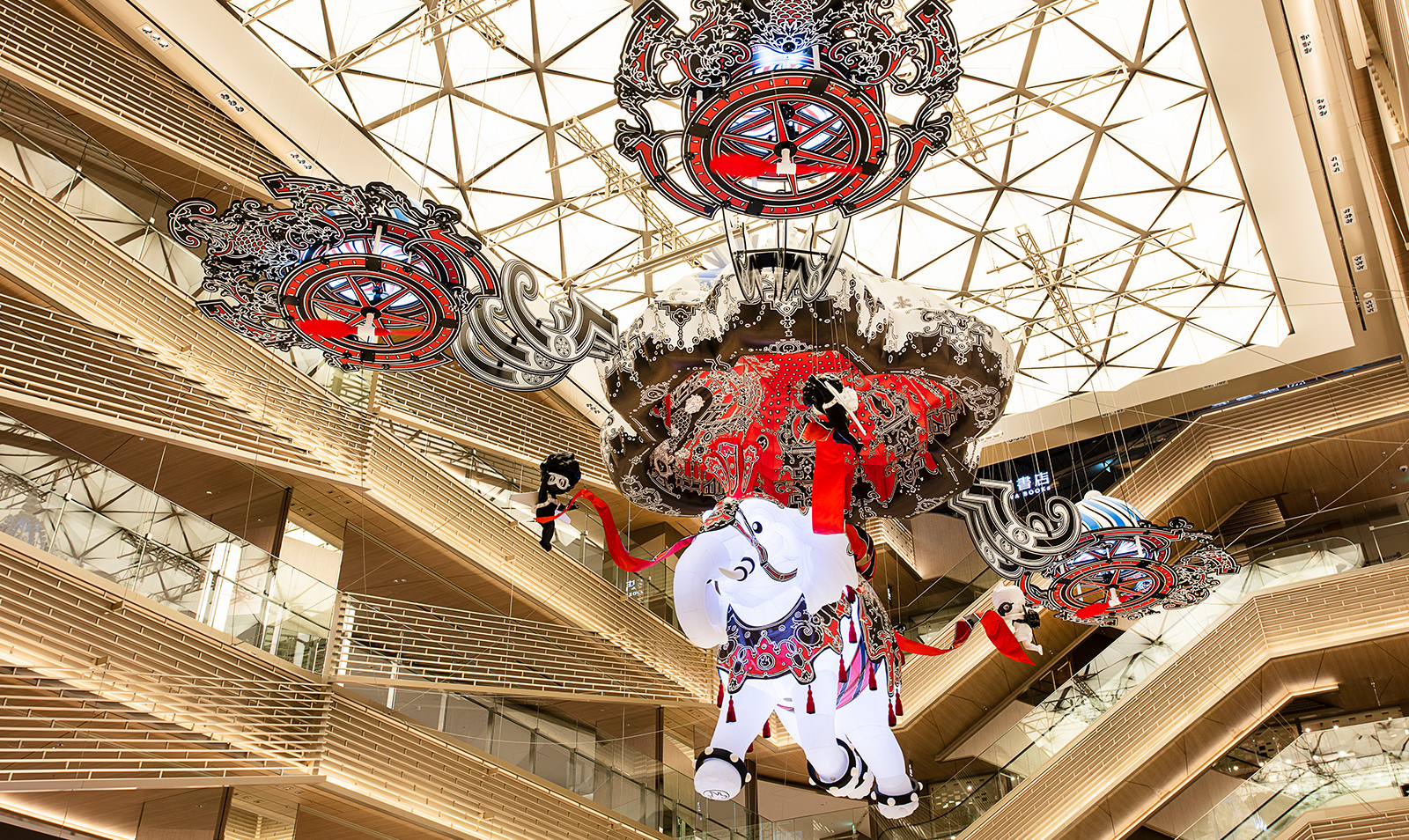
-
Nicolas Buffe
《 ”Fantastic Gift” The Story of the Kingdom of Winter and the Kingdom of Summer 》
2F Central Atrium
November 12, 2018 - February 20, 2019
During the 2018 holiday season, the central atrium space featured “Shining Elephant,” a work three meters high and more than four meters long. The installation showed the Putti, or little angels, delivering the elephant by drone from the Kingdom of Summer to the Kingdom of Winter, reenacting one of the scenes from the story.
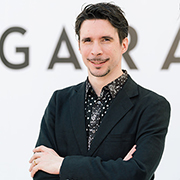
Nicolas Buffe
Born in Paris, France, in 1978, and relocated to Tokyo in 2007, Nicolas Buffe creates his own unique worlds through a remarkable blending of Japan’s anime culture, an influence since his youth, with American subcultures, based on the background of baroque art, and traditional forms of European culture from the medieval and Renaissance periods. Inspired by the humanist concept of serio ludere, or serious play, his works incorporate visual elements and interactive experiences fused with narrative elements.
-
Daniel Buren
《 Like a flock of starlings: work in situ 》
2F Central Atrium
April 2, 2018 - October 31, 2018
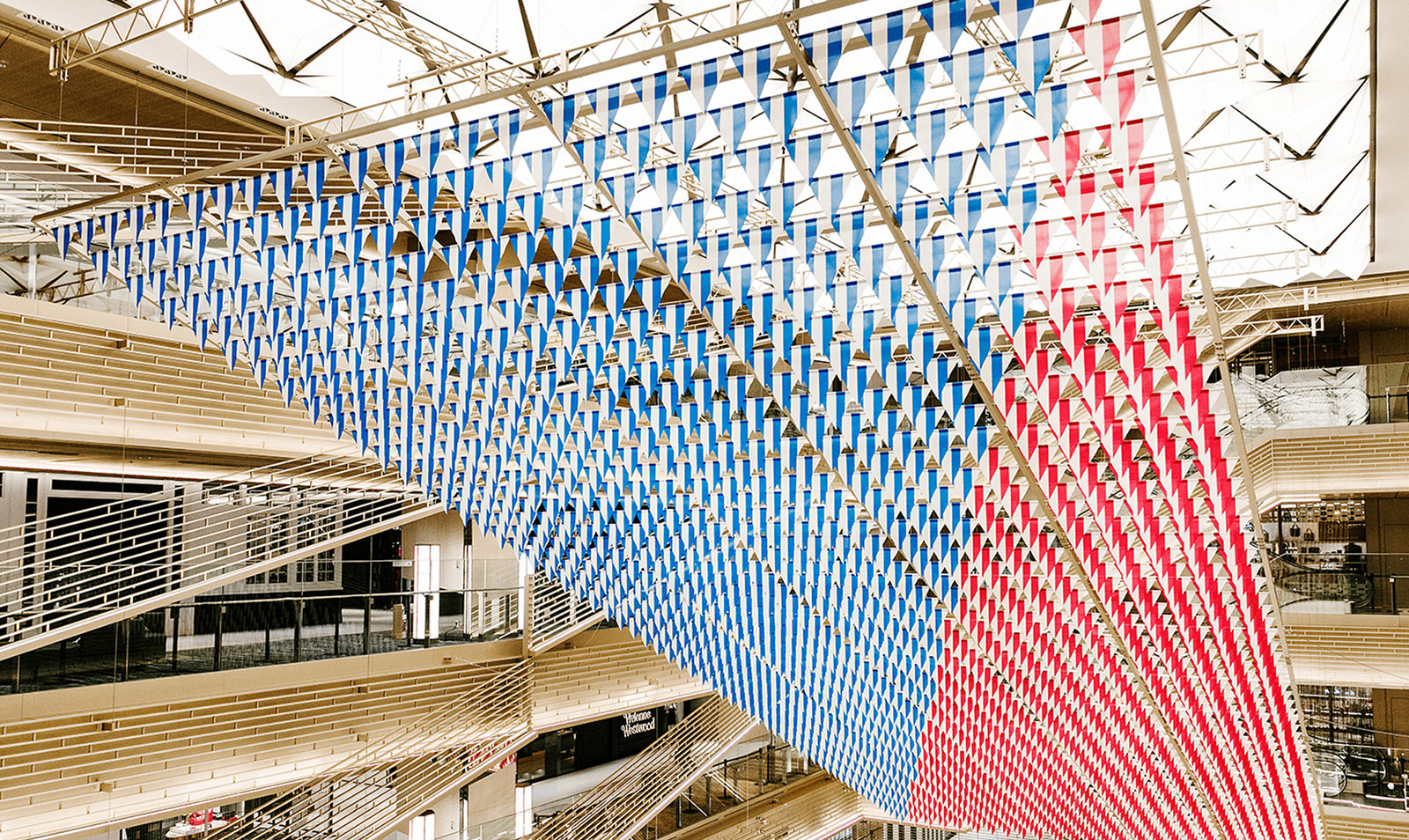
On its first anniversary, the central atrium space at GINZA SIX hosted a new art installation by French artist Daniel Buren, who has produced numerous artwork globally over fifty years, featuring his signature 8.7-cm-wide striped flags. A total of 1,500 of the flags in red and blue enlivened the space.
Supervised by Mori Art Museum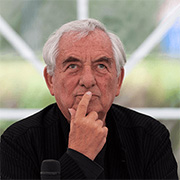
Daniel Buren
Artist. Born in Paris, France, 1938. Starting in 1965, based on a self-conceived notion, Buren has produced numerous works that feature 8.7 cm wide stripes. His works have appeared in many forms, genres, media, and locations, including paintings, sculpture, murals, and buildings. To date, he has exhibited several thousands of works. In 1986, he was awarded the Golden Lion after entering the Biennale di Venezia as the French representative. He was the 2007 laureate of the Praemium Imperiale in the painting field. In 2016, his exhibition at the Fondation Louis Vuitton art galleries in Paris, designed by Frank Owen Gehry, caused a sensation. In Japan as well, he has participated in numerous art festivals and installed permanent exhibitions, including the Yokohama Triennale 2005 and Ibaraki’s Kenpoku Art (2016).
© DB - ADAGP, Paris & JASPAR, Tokyo, 2018 G1226
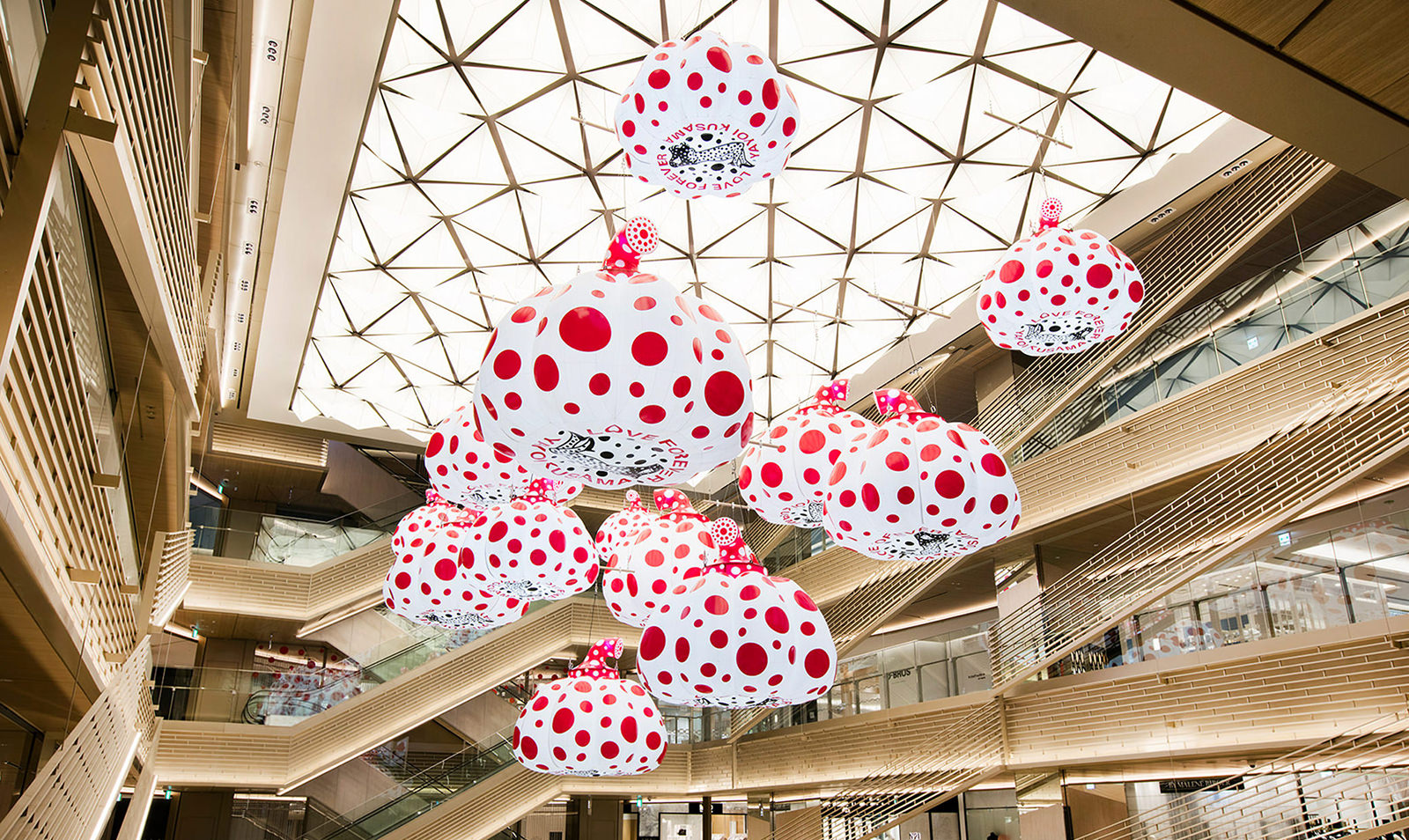
-
Yayoi Kusama
《 Pumpkin 》
2F Central Atrium
April 20, 2017 - March 21, 2018
Under the supervision of the Mori Art Museum, the grand opening will be celebrated with the latest installations of the avant-garde artist Yayoi Kusama. Ever since her involvement in the 60s New York art scene, Yayoi Kusama has gained international attention, becoming one of the best known Japanese artists in the world.
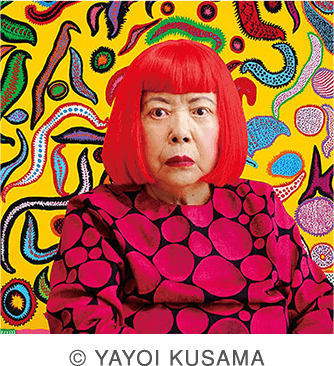
Yayoi Kusama
Yayoi Kusama was born in 1929 in Matsumoto, Nagano Prefecture. She studied Japanese art before relocating to the United States in 1957, and began her creative career in New York. Her innovative expressions captured admiration internationally, and in 1998 she became the first Japanese artist to have a solo exhibition at MoMA.
© YAYOI KUSAMA / Photo: Ken Kato
ART NEWS
-
Art
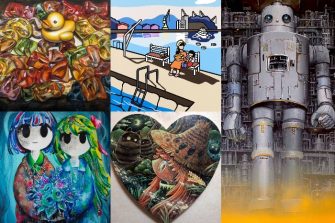
Artglorieux GALLERY OF TOKYO
鮮やかな記憶:日常の瞬間の捉え方 4/10(木)~4/16(水)
-
Gallery
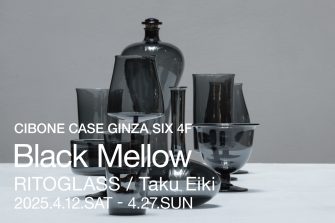
CIBONE CASE
【CIBONE CASE】黒を纏ったガラス作品が並ぶ RITOGLASSの個展を開催
-
Art
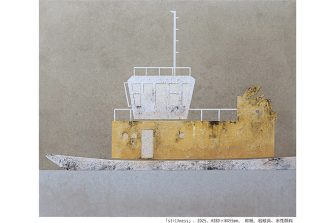
銀座 蔦屋書店
甲村有未菜展 - 而今 -
SHOW WINDOW
-
-
Pranks inc.
《 Spring: Floral Feast 》
Read The ArticleB2F Window Display
2025.4.4 - 2025.6.12
-
-
In Japan, meats can be represented by flowers and plants. For example, horse meat may be called cherry blossoms; boar meat peonies; venison Japanese maple; and chicken kashiwa oak. These are poetic ways of referring to meat by likening their qualities to flowers and plants. The origins of this practice date back to the Edo Period (1600-1868), when eating meat openly was prohibited due to the influence of Buddhism, which resulted in a secret language to avoid explicit mention of its consumption.
A closer examination shows that the colors or textures of individual meats resonate with the colors of the flowers or shapes of the leaves of plants. Avoiding direct reference—likening subjects instead to beautiful flora evocative of nature and the seasons—attaches a certain elegance and beauty to food equivalent to the graceful expression of Japanese poetry.
Likening meats to beautiful flora may also express a sense of gratitude and respect for the animal in question. The greeting itadakimasu, still used today at the start of a meal in Japan, similarly expresses gratitude for all of nature’s blessings.
Today, with the consumption of meat now commonplace, these euphemisms are appealing due to their playful spirit as an ingenious way of indirectly referring to food. The culture of inference of perceiving elegance and refinement in indirect expressions is an aesthetic that may still be alive today.
The work Floral Feast embodies the Japanese sense of incorporating the beauty of nature into everyday life and gratitude for the lives given to us in the form of food. We hope visitors will enjoy the flowers in this work in keeping with the season.Art director: Yasuko Sato
PUBLIC ART GINZA SIX suggests a rich lifestyle where art can be accessed easily by providing its guests a chance to see various types of art up close. Under the supervision of Mori Art Museum, GINZA SIX exhibits a choice of three globally praised artists and their art pieces at all times.
-
-
Shinji Ohmaki
《 Echos Infinity -Immortal Flowers- 》
2F, 3F, 4F, 5F South Elevator Hall
Supervised by Mori Art Museum -
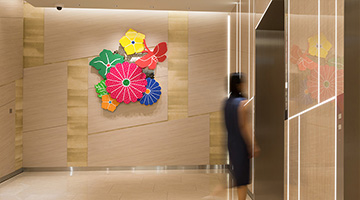
View
Movie
-
-
A sculpted peice combining Edo-komon-style printed morning glories, Chinese bellflowers, chrysanthemums, and butterflies. Edo-komon is an exquisite Japanese style of print that brings out the uniqueness in detailed, strictly-formatted prints. This design is the end result of Japanese craftsmen competing for a more detailed, smaller, and thinner patterned designs, which was encouraged by the law established during the Edo period to ban extravagant, flashy kimonos. *Writer’s Message “Arranging an eternal flower that will pass on the accumulation of time, memories, culture and emotions that lie here amongst us to the future.”
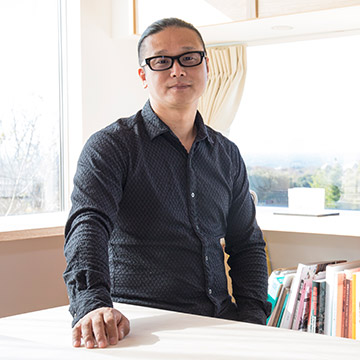
Shinji Ohmaki
Born in Gifu Prefecture in 1971. Ohmaki continues to announce dynamic installations and public art pieces which awake the viewers’ physical senses.
Photo: Ken Kato
-
-
Misa Funai
《 Paradise/Boundary/Portrait 》
3F, 4F, 5F North Elevator Hall
Supervised by Mori Art Museum -
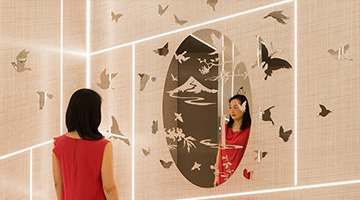
View
Movie
-
-
Featuring “Paradise and Boundaries” as the theme, Funai captures the full space as her canvas and expresses the intersection of the painted world and reality through using mirrors. The person standing in front of the piece is reflected in the painting, consequently transforming the viewer into the leading character. By painting a fictional paradise that resides in anyone's mind, people passing by and the scenery of reality mix with the imaginary world, turning over each the ideal and reality – the 2 dimensional and 3 dimensional, the existent and nonexistent, the past and the present – into one, thus creating a new world and vision. This symbolizes that the future is shaped by people’s imagination.
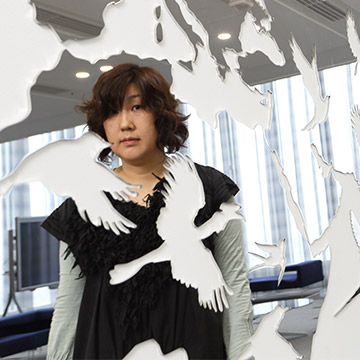
Misa Funai
Born in Kyoto in 1974. Graduated from Tsukuba University with a Master’s degree in art research in 2001. Exhibits include “VOCA An outlook of contemporary paintings – artists with a new dimension” at Ueno Royal Museum in 2009/2010, “Wonderful World” at Museum of Contemporary Art Tokyo in 2014.
-
-
Yuumi Domoto
《 Tami 》
3F, 4F, 5F Passage
Supervised by Mori Art Museum -
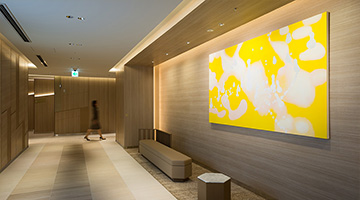
View
Movie
-
-
The piece newly made for GINZA SIX is painted by layering dramatic shapes onto drifting colors, thus creating a deep and massive space. The spacious and infinite feeling of the piece gives us the impression of the unconscious mind, while the shapes drawn as though they were dancing brings out what we can visualize (our conscious minds). The painting located just steps away from the retail area lures viewers into Domoto’s artistic space where the conscious and unconscious coincide.
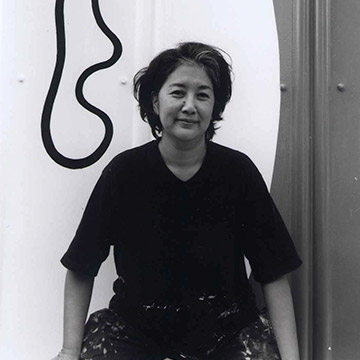
Yuumi Domoto
Born in Paris, 1960. After graduating from Tama Art University with a degree in painting, graduated from Cooper Union Art Division (New York). Starting off with her private show at Sagacho Exhibit Space, she participated in numerous exhibitions within Japan and overseas.
LIVING WALL ARTOn the two 12m-long living walls (located on the Chuo-dori side and the Mihara-dori side open-ceiling space) are two paired art pieces, produced by JTQ Junji Tanigawa.
-
-
teamLab
《 Universe of Water Particles on the Living Wall 》
Living Wall Chuo-dori Side Open-Ceiling Space
Size: H11,810×W1,920 mm
Art Type: Digital Installation, LED, Endless -
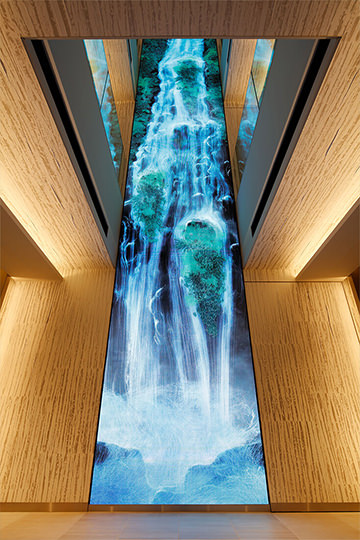
View
Movie
-
-
An installation piece portraying a waterfall that changes its appearance according to the changing light of the sun. “In other words, there are 1000 times more water particles behind the countless lines, and the mutual influence among them is what decides the curve of the lines. By creating the rock inside an imaginative three-dimensional space, we let the water fall. The water is expressed by countless particles of water, and is calculated by the mutual influence among the particles. The waterfall is constructed as a physical simulation of water, and through the movement of a randomly selected 0.1% water particle, we draw a line over the space. The waterfall is created by the sum of those lines.”

teamLab
A group of digital technology experts including programmers, engineers, CG animators, illustrators, mathematicians, architects, web designers, graphic designers, and editors. Under the concept of collective creation, they work beyond the boundaries of art, science, technology and creativity.
© KOZO TAKAYAMA
-
-
Patrick Blanc
《 Living Canyon 》
Living Wall Mihara-dori Side Open-Ceiling Space
Size: H11,020×W2,700 mm
-
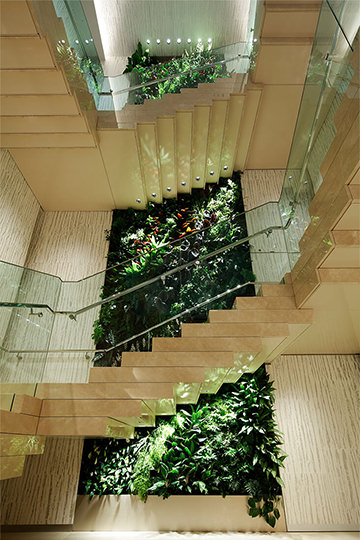
View
Movie
-
-
A Patrick Blanc original, this vertical two-dimensional art piece, which contains no soil, mixes numerous plants including those particular to the Japanese land. As can be seen from the title, the piece expresses a deep, shaded ravine illuminated from sunlight from the top of a cliff. The reason why different plants survive under the ever-changing weather is because each species adapts perfectly to a particular type of light energy. The diversity of vegetation reflects the beauty, creativity, and tactics of the biological world.
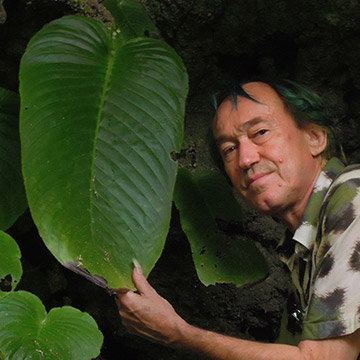
Patrick Blanc
Born in 1953 in Paris. A botanist and artist, he is known for creating vertical gardens. His major works include “Green Bridge,” which features plants growing over a glass corridor.
© KOZO TAKAYAMA


